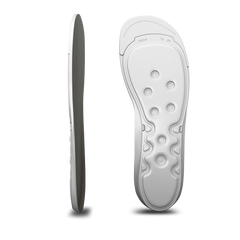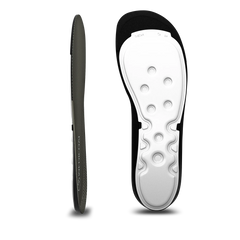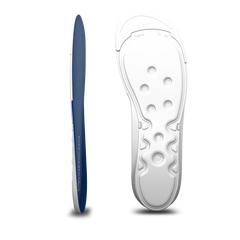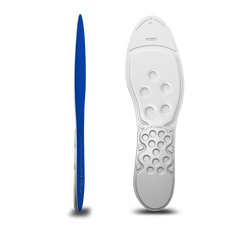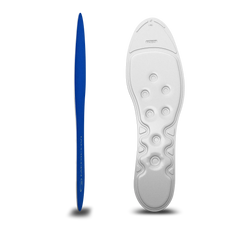Heel Spur: Origin, Conservative Treatment, and Shockwave Therapy

Do you suffer from foot pain, especially in the heel area? Do you experience sharp heel pain, especially in the morning after waking up? Or after prolonged periods of sitting or standing followed by walking? In such cases, you likely have a heel spur or plantar fasciitis, and this article should be of help.
A heel spur (also known as plantar fasciitis when associated with inflammation of the plantar fascia) is a bony growth on the bottom of the heel bone. The heel spur, also known as a calcaneal spur, develops gradually as calcium deposits accumulate on the heel bone (calcaneus). This leads to the formation of a protrusion or spike on the bone. Genetically, we as hunters and gatherers, have adapted to walk barefoot on hard and uneven surfaces. While doing this, the ligaments are exercised. Nowadays, we mostly walk on flat surfaces. We wear tight shoes with molded (supportive) arch sections. Wearing this type of footwear significantly reduces the movement of the longitudinal ligaments of our feet (plantar fascia), reducing the flexibility of these ligaments. Inadequate flexibility of the longitudinal ligaments (especially the plantar fascia) can cause tissue damage, even with minimal stress. When a tear occurs there will be inflammation, which is known as plantar fasciitis. The tear is then covered over by scar tissue, which is much less elastic than the plantar fascia itself, resulting in intense foot pain. If the plantar fascia loses its elasticity, it is felt as a shortening of the ligament, which results in pain in the Achilles tendon under any load.
Factors that can contribute to the development of a heel spur include:
- Prolonged foot stress,
- Wearing inappropriate footwear,
- Wearing footwear with molded arch sections that unnaturally hold the foot in one position,
- Going barefoot or wearing minimalist (barefoot) shoes on hard flat surfaces (sidewalks, pavement, etc.),
- Excess weight,
- Flat feet, or
- High arches.
How does a heel spur develop?
It develops due to the calcification of a ligament, which hurts because it extends into the heel bone. The repeated overloading and damaging of ligament and bone tissue can lead to the formation of a bony growth.
Diagnosis of a heel spur:
Diagnosing a heel spur involves several steps and methods to determine the presence and extent of this condition. Here are the most common steps in the diagnostic process:
Medical history: The doctor will ask about your symptoms, pain history, and any previous injuries or conditions that may be related to heel pain.
Physical examination: The doctor will examine the heel area for any visible signs of inflammation, swelling, or redness. He/she may also perform a palpation check to identify the exact location of your pain.
Imaging studies: The most commonly used imaging study for diagnosing a heel spur is one or more X-ray. X-rays can reveal the presence of a bony growth on the heel bone. In some cases, other imaging techniques like ultrasound or magnetic resonance imaging (MRI) may be used, especially if the doctor suspects other issues such as ligament injuries or soft tissue damage.
Gait analysis and foot posture evaluation: The doctor may also assess your gait and foot posture to determine whether there are biomechanical issues contributing to the pain.
Differential diagnosis: Since heel pain can be caused by various conditions, such as plantar fasciitis, Achilles tendinitis, or arthritis, the doctor may need to rule out these and other possible causes to accurately diagnose the source of the pain.
Conservative treatment:
Conservative treatment is often the first choice for patients suffering from heel pain caused by a heel spur. This treatment includes the following steps:
- Rest: An important step is rest and reducing activities that cause pain. This may involve taking a break from sports activities or wearing shoes with better support.
- Icing: Applying a cold compress to the affected area can help reduce inflammation and pain.
- Exercise: Physical therapy exercises aimed at strengthening and stretching the leg and foot muscles can help maintain proper walking mechanics.
Shockwave therapy:
If conservative treatment does not yield the desired results, the doctor may consider shockwave therapy. This is a non-invasive procedure that uses shockwaves to break up the bony growth and stimulate healing. Shockwave therapy is also known as extracorporeal shock wave therapy (ESWT), and is a commonly used method for treating various orthopedic conditions like heel spurs, tendinitis, and others.
However, like any medical treatment or procedure, shockwave therapy comes with some disadvantages and potential risks:
- Pain during the procedure: Although shockwave therapy is non-invasive, some patients may feel pain or discomfort during the procedure.
- Temporary worsening of symptoms: After the procedure, some patients may experience a temporary increase in pain or swelling in the treated area before experiencing relief.
- Uncertainty about the effectiveness: In some cases, shockwave therapy may not provide pain relief, or the effect may be partial or delayed.
- Multiple sessions may be required: Complete treatment often requires several sessions, which can be time-consuming and financially burdensome.
- Post-procedure restrictions: After shockwave therapy, patients may be advised to limit physical activity, which can be inconvenient for those accustomed to an active lifestyle.
- Not suitable for all patients: Shockwave therapy may not be suitable for certain patient groups, such as pregnant women, people with bleeding disorders, or those taking anticoagulant medication.
- Possible side effects: Like any medical procedure, there is a risk of side effects such as bruising, swelling, redness, or, in rare cases, tissue damage.
- Limited insurance coverage: Not all health insurance plans cover shockwave therapy, which can be financially challenging for patients who have to pay for the procedure themselves.
Heel spur surgery:
Heel spur surgery is a procedure performed when conservative treatments and other non-invasive methods fail to provide relief from the heel pain and inflammation caused by the heel spur. Various surgical procedures can be used to remove the heel spur, and the choice of the most suitable procedure depends on the patient's individual condition. Heel spur surgery is usually considered a last resort when more conservative methods fail. Surgery carries the risk of incomplete pain relief, and in some cases the pain can return over time.
Treatment of a heel spur with growth factors from blood plasma:
Treatment of a heel spur with growth factors from blood plasma, known as PRP (Platelet-Rich Plasma) therapy, is an advanced regenerative medical technique that uses the patient's own blood to stimulate healing in affected areas. Blood is drawn from the patient, then centrifuged to separate the platelet-rich growth factor from other blood components.
This concentrated PRP is then injected into the area of the heel spur to support the natural healing and tissue regeneration process. Growth factors present in PRP are responsible for attracting immune cells, promoting the formation of new blood vessels, and stimulating cell growth, which can contribute to the repair of damaged ligaments and pain relief. While this type of therapy shows promise and can be effective for some patients, it's important to discuss with your doctor the potential benefits and risks of this treatment because scientific data on its effectiveness are still being researched, and further research may be needed to confirm its long-term effects.
Radiation therapy for a heel spur:
Radiation therapy for a heel spur (or radiotherapy) is a treatment method sometimes used to address the chronic pain caused by the spur, especially in cases where conventional treatments such as physical therapy, supportive footwear, or anti-inflammatory medications have not provided sufficient relief.
Radiation therapy, while potentially effective in alleviating pain, comes with several potential risks and side effects, which include:
- Risk of developing a malignancy: Although the risk is considered low, the use of ionizing radiation always carries some risk of developing cancer. The long-term effects on tissue in the irradiated area are a subject of discussion and research.
- Skin reactions: Skin reactions, such as redness, peeling, or even ulcers, may occur at the radiation site, although these side effects are usually mild and temporary.
- Possible worsening of symptoms: In some cases, radiation therapy may temporarily worsen pain or inflammation before the condition improves.
- Tissue changes: Radiation can cause changes in tissue and in the structures around the heel, which may have long-term effects, although these are relatively rare.
- Interactions with other conditions: Patients with certain medical conditions, such as autoimmune diseases or diabetes, may be more susceptible to the side effects of radiation.
- Limited data on long-term effects: Although current studies suggest that low-dose radiation therapy is relatively safe, there is still limited long-term data on its safety and efficacy.
Conclusion:
Before starting treatment for a heel spur, it is essential that you consult with a doctor, preferably one who specializes in orthopedics.
Exercises suitable for heel spur treatment (video tutorial):
For the treatment of a heel spur, the following exercises may be effective in strengthening the muscles and ligaments of the feet, especially the plantar fascia and Achilles tendon:
